Photo albums from this trip (more photos than shown on this page) are here.
At Lima‘s airport, the immigration queue was long but moved quickly (unlike in Venezuela). I eventually spotted my name on a sign and was collected by my guide and driver, who took me to my hotel, the Sol de Oro in Miraflores. I had arranged for transportation between the airport and my hotel, in both direction, for all of my stops in Peru: a slightly expensive solution, but I did not want to take my chances alone in a country where I don’t speak the language.
The hotel room was large and comfortable, but there was no bottled water and the minibar was locked (I forgot to ask the porter to unlock it). I had water with me, so this was no problem. I found a sharp enough implement to cut the shrinkwrap off my luggage (my knife and scissors were, of course, inside the bag). Finally collapsed into bed around 1 AM.
Tuesday, 21 July. Up early. Good breakfast buffet (eggs, toast, yoghurt, fresh tropical fruit, orange juice, strange tea). I was collected at 09:30 for the drive to the airport. Rain had just stopped, and the streets were full of water. The guide said it rarely rains in Lima, so they don’t have drains! There was a transport strike, so even more cars than usual were on the road, causing gridlock at some intersections. Much tooting of horns and argumentative arm-waving as cars tried to cut into the traffic stream from side streets. Quite a contrast to Venezuela.
Still, we got to the airport in time, stood in a long but fast-moving bag-drop queue (guide had printed my boarding pass in advance for me), paid the airport fee (just under US$6), and hung around for awhile before the short flight to Cusco. Discovered that I could take bottled water through security for domestic flights, but not for international ones. I couldn’t find a currency exchange booth after security
 I had a good seat for getting a good view—and some photos—of the Andes and of Cusco as we arrived. As in many smaller Australian airports, there was no airbridge; we walked down some steps to the ground, then up a long switchback ramp into the airport… thus giving us all an appreciation for the effects of the altitude (puff-puff).
I had a good seat for getting a good view—and some photos—of the Andes and of Cusco as we arrived. As in many smaller Australian airports, there was no airbridge; we walked down some steps to the ground, then up a long switchback ramp into the airport… thus giving us all an appreciation for the effects of the altitude (puff-puff).
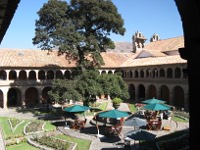 In the airport’s baggage collection area, a small group in traditional dress were playing drums and panpipes. I found my driver outside; was taken to the Hotel Monasterio, a former monastery in a labyrinth of tiny alleys in the old town, just a block uphill from the main square. The hotel is a beautiful building with a lovely internal square featuring an ancient tree. In keeping with its 5-star status and price, the staff-to-guest ratio is high and the service excellent.
In the airport’s baggage collection area, a small group in traditional dress were playing drums and panpipes. I found my driver outside; was taken to the Hotel Monasterio, a former monastery in a labyrinth of tiny alleys in the old town, just a block uphill from the main square. The hotel is a beautiful building with a lovely internal square featuring an ancient tree. In keeping with its 5-star status and price, the staff-to-guest ratio is high and the service excellent.
 My only activity for the day was to rest, drink some coca tea (tastes vile but is supposed to be good for helping one avoid altitude sickness because it increases the absorption of oxygen in blood) and acclimate to the altitude. Three small bottles of water are supplied gratis each day. More water, plus fruit juice and other items, were for sale in the minibar. The room had a safe, and strong suggestions that I use it for any valuables such as my passport.
My only activity for the day was to rest, drink some coca tea (tastes vile but is supposed to be good for helping one avoid altitude sickness because it increases the absorption of oxygen in blood) and acclimate to the altitude. Three small bottles of water are supplied gratis each day. More water, plus fruit juice and other items, were for sale in the minibar. The room had a safe, and strong suggestions that I use it for any valuables such as my passport.
Dinner in the hotel’s restaurant was seared alpaca loin with wild mint, cape gooseberry & quinoa risotto, and glazed vegetables, for a reasonable $US26, accompanied by a glass of very nice wine (marbec-merlot blend).
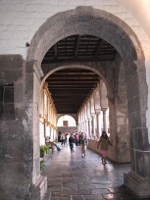
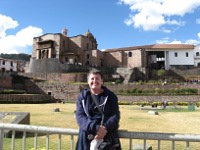 Wednesday afternoon, 22 July, was a city tour, featuring Inca ruins and examples of what the Spanish did to build monasteries and other Catholic buildings on top of old temples, using stone from other Inca constructions. Qorikancha, the Temple of the Sun, was an impressive place that I would like to have had more time to appreciate.
Wednesday afternoon, 22 July, was a city tour, featuring Inca ruins and examples of what the Spanish did to build monasteries and other Catholic buildings on top of old temples, using stone from other Inca constructions. Qorikancha, the Temple of the Sun, was an impressive place that I would like to have had more time to appreciate.
Saqsayhuaman was in a greater state of ruin (having been plundered by the Spaniards) but included more fine examples of the way the Incas fit stone together… stone that had come from far away from its present location. The guide also explained how earthquakes over the years have destroyed some of the Spanish construction while the Inca construction survived.
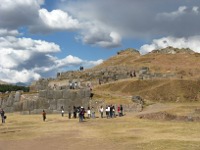 We also toured the Cathedral of Santo Domingo, located on the main square, the Plaza de Armas. The foundation of the cathedral was an Inca palace, with most of the building materials taken from Saqsayhuaman. The guide showed us many examples of Inca religious symbols worked into the church decoration (stone carvings, paintings copied from European works) by the local artisans. Photography was not permitted, so I can’t show you any examples. In the evening, I enjoyed more delicious food and wine at the Monasterio.
We also toured the Cathedral of Santo Domingo, located on the main square, the Plaza de Armas. The foundation of the cathedral was an Inca palace, with most of the building materials taken from Saqsayhuaman. The guide showed us many examples of Inca religious symbols worked into the church decoration (stone carvings, paintings copied from European works) by the local artisans. Photography was not permitted, so I can’t show you any examples. In the evening, I enjoyed more delicious food and wine at the Monasterio.

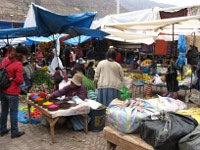 Thursday, 23 July: an all-day bus tour to Sacred Valley: outdoor markets (largest at Pisac), views of terraced mountainsides, more Inca ruins (including Ollantaytambo, which I skipped because my legs hurt and it was raining), various alpacas, llamas, burros, sheep, cattle. Stunning country, a bit of rain, cold (glad I brought my heavier sweatshirt as well as my lightweight jacket). Fabulous views from the heights. Very nice buffet lunch in some small town; entertained by a panpipe player.
Thursday, 23 July: an all-day bus tour to Sacred Valley: outdoor markets (largest at Pisac), views of terraced mountainsides, more Inca ruins (including Ollantaytambo, which I skipped because my legs hurt and it was raining), various alpacas, llamas, burros, sheep, cattle. Stunning country, a bit of rain, cold (glad I brought my heavier sweatshirt as well as my lightweight jacket). Fabulous views from the heights. Very nice buffet lunch in some small town; entertained by a panpipe player.
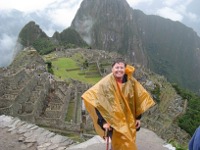 Friday, 24 July: to Machu Picchu by train, after checking out of the hotel and leaving my big suitcase behind, taking only my daypack. Drizzle with occasional rain. Mountains towering over the tracks. The 50-something American man sitting across from me expressed surprise that I was travelling by myself (he was accompanied by his 20-something daughter and seemed inexperienced at independent travel), but concluded: “Good for you!”
Friday, 24 July: to Machu Picchu by train, after checking out of the hotel and leaving my big suitcase behind, taking only my daypack. Drizzle with occasional rain. Mountains towering over the tracks. The 50-something American man sitting across from me expressed surprise that I was travelling by myself (he was accompanied by his 20-something daughter and seemed inexperienced at independent travel), but concluded: “Good for you!”
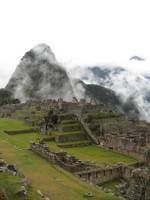 Bus from train terminus at Aguas Calientes up steep switchbacked road to entrance to MP, where my hotel (Sanctuary Lodge) is located. The height to Machu Picchu from the Urubamba River (and the train station at Aguas Calientes) is approx. 400 metres, about 6km by the road.
Bus from train terminus at Aguas Calientes up steep switchbacked road to entrance to MP, where my hotel (Sanctuary Lodge) is located. The height to Machu Picchu from the Urubamba River (and the train station at Aguas Calientes) is approx. 400 metres, about 6km by the road.
Tour of ruins in a group of a dozen people, led by a historian named Darwin Camacho, author of The True History of Machu Picchu, which I should have bought. Descriptions and photos cannot convey how awesome this place is. Most of the classic photos show only a small part of the ruins. My knees simply would not allow me to climb up and down as much of the area as I wanted to, but I kept up with the tour and saw quite a bit—even if, in some cases, from afar. The continuing drizzle and rain was only a minor impediment (though I had to be particularly careful about slippery stone steps). Lots of tourists were there, but perhaps not as many as might have arrived on a day of better weather.
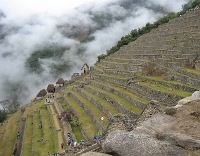 Tasted my first pisco sour in the Sanctuary Lodge’s bar that evening. Yum! Delicious dinner of chicken breast stuffed with mushrooms, accompanied by a few vegetables and seasoned rice. The view was impaired by the clouds, but now and then a mountain peak would appear.
Tasted my first pisco sour in the Sanctuary Lodge’s bar that evening. Yum! Delicious dinner of chicken breast stuffed with mushrooms, accompanied by a few vegetables and seasoned rice. The view was impaired by the clouds, but now and then a mountain peak would appear.
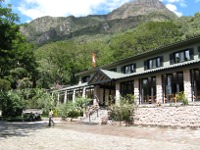 The next day I had to check out early, but did not have to go back to the train station until mid-afternoon. The weather improved, so I was able to explore some of the Lodge’s beautiful gardens terraced up part of the hillside, with a small cascade of water into a pond, and outdoor lounge chairs and tables for guests. There is also a “day room” for people like me to sit and read or watch TV or gaze out at the view after we’ve been forced to check out of our rooms. I could have bought a ticket to visit the ruins again, but my knees simply could not do it.
The next day I had to check out early, but did not have to go back to the train station until mid-afternoon. The weather improved, so I was able to explore some of the Lodge’s beautiful gardens terraced up part of the hillside, with a small cascade of water into a pond, and outdoor lounge chairs and tables for guests. There is also a “day room” for people like me to sit and read or watch TV or gaze out at the view after we’ve been forced to check out of our rooms. I could have bought a ticket to visit the ruins again, but my knees simply could not do it.
Eventually I took the bus back down the mountain and caught the train back to Cusco. This was not without its minor excitement: when I got off the bus, I couldn’t see the station as there was a big market set up alongside the river. Other obvious tourists (with luggage) were wandering around looking equally confused. Eventually we stumbled upon the station, where boarding the train was an extremely inefficient process. After a long queue to have tickets checked, I had to walk to the car furthest away from the checkin area.
Once we had all boarded, the train left quickly, only a bit behind schedule. After the snack served on board, the train staff staged a fashion show of clothing made from Peruvian alpaca and other animal fibres. From the train station a shuttle bus returned me to the Monasterio Hotel, where I checked into a different room and found my bag awaiting me. Thorough collapse time!
The next morning after a good breakfast in the Monasterio’s breakfast room, I would fly back to Lima for another overnight stop before heading on to my next Peruvian destination, Arequipa. When my guide arrived to drive me to the airport, he was most apologetic that I would have to walk several blocks (with him dragging my big suitcase over the cobblestones) because much of the old city was closed to traffic for some Sunday event. There was very little traffic all the way to the airport. Although the bag drop-off queue was long, the security queue was short. For some reason my artificial hips did not set off the alarm, for the first time on this trip.
